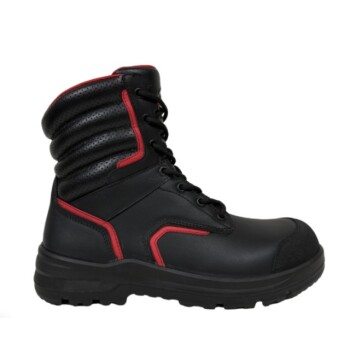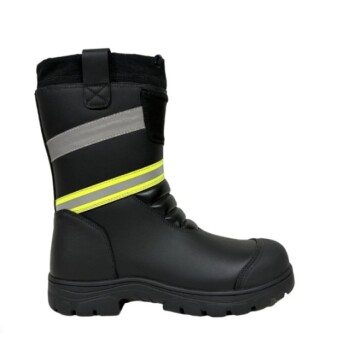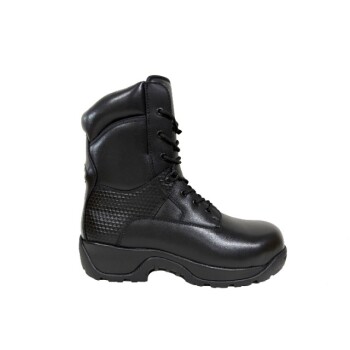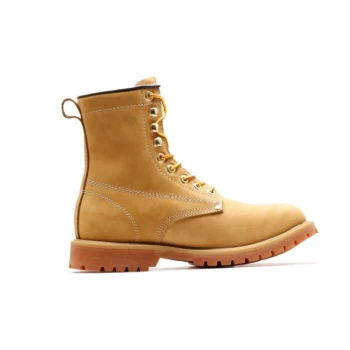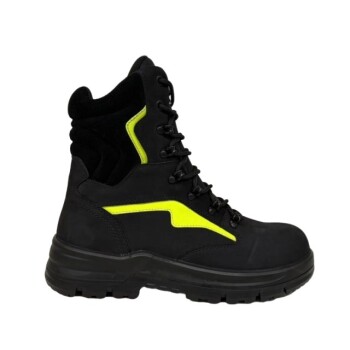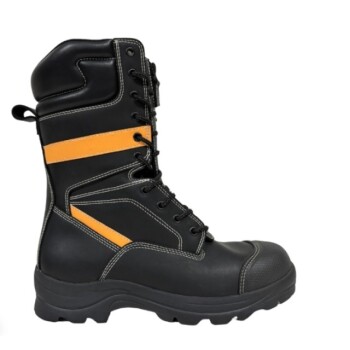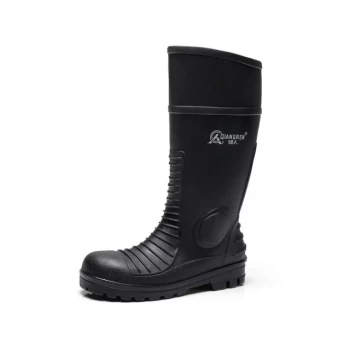At its core, the difference is in their heritage and intended function. A logger boot is a pure, heavy-duty work boot designed for maximum stability and protection on unforgiving terrain. A packer boot is a hybrid, blending the ruggedness of a work boot with the distinct features of a Western riding boot, making it versatile for both groundwork and time in the saddle.
The choice between a logger and a packer is a choice between specialization and versatility. Loggers offer uncompromising stability for work on foot, while packers are built to function equally well on the ground and in a stirrup.
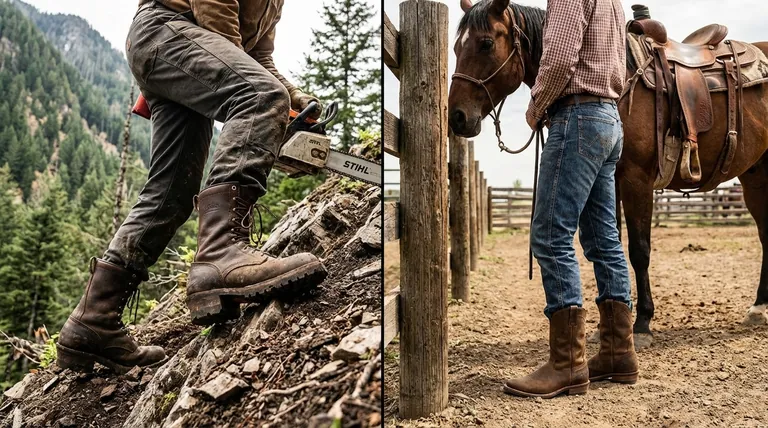
The Logger Boot: Engineered for Unforgiving Terrain
Logger boots are purpose-built tools for professionals who work on their feet in the most demanding environments, such as forestry, wildland firefighting, and line work. Their design prioritizes stability above all else.
The Defining Feature: The Logger Heel
The most recognizable feature is the tall, stacked heel, often measuring two inches or more. This high heel is designed to provide exceptional arch support and to dig into soft or steep ground, preventing slips when climbing or traversing hillsides.
The "Logger Counter": Maximum Heel Support
Loggers are constructed with a large, tall, and wide heel counter. This is the stiff piece of material that wraps around the back of the boot. Its purpose is to lock your heel firmly in place, minimizing internal foot movement and providing critical ankle stability on uneven surfaces.
The Overall Profile: Purely Functional
A logger boot is unapologetically robust. It typically features a rounded or bulbous toe box (often with a safety toe) and a heavy-duty lugged sole designed for aggressive traction. The focus is entirely on performance and protection.
The Packer Boot: A Hybrid of Work and Western
The packer boot traces its lineage to the American West, designed for those who spent their days both on foot and on horseback. It masterfully combines the features of a work boot with the specific needs of a rider.
The Western Heritage: Riding-Focused Design
Packers inherit their sleeker profile and distinct shape from traditional cowboy boots. This influence is most obvious in the boot's toe shape and heel counter.
The "Packer Counter": A More Trimmed Profile
Compared to a logger, a packer has a smaller heel counter that is not as tall or wide. While still providing excellent support, this trimmed-down design contributes to a less bulky boot that is more comfortable for long periods in the saddle.
The Tapered Toe: Designed for the Stirrup
Packers almost always feature a more tapered or pointed toe box. This is a direct carryover from riding boots, as this shape allows for quick and safe entry and exit from a saddle stirrup.
Understanding the Trade-offs
Choosing between these styles requires understanding their inherent compromises. Neither is universally "better"; they are simply better for different tasks.
Stability vs. Versatility
The logger's large heel counter offers superior stability for walking on rough ground, but its bulk can feel cumbersome for other activities. The packer's design is a direct compromise, sacrificing a small amount of that ground stability for better function in a stirrup.
Toe Box and Fit
The fit is not interchangeable. The broad, rounded toe of a logger provides ample room for your toes to splay, which is ideal for walking. The tapered toe of a packer, while essential for riding, can feel more restrictive to someone accustomed to a traditional work boot fit.
Aesthetics and Application
The logger has a singular, functional aesthetic. The packer, with its Western roots, often has a more classic or heritage look that some find more versatile for casual wear. However, the function should always dictate the choice for work purposes.
Making the Right Choice for Your Task
Your primary activity is the only factor that matters. Analyze your needs honestly to select the boot that will serve you best.
- If your primary focus is working on steep, uneven terrain (logging, forestry, line work): The logger boot is the correct choice for its superior heel lock and ground stability.
- If your primary focus is a mix of groundwork and horseback riding (ranching, packing): The packer boot offers the ideal versatility with its stirrup-friendly toe and solid walking platform.
- If your primary focus is maximum support and safety in a traditional work boot: The logger is the definitive tool for the job.
- If your primary focus is a versatile and durable boot with a Western-inspired profile: The packer provides excellent support while fitting this stylistic preference.
Ultimately, understanding the design philosophy behind each boot is the key to choosing the right tool for your work.
Summary Table:
| Feature | Logger Boot | Packer Boot |
|---|---|---|
| Primary Function | Heavy-duty work on foot | Hybrid: Work & horseback riding |
| Heel | Tall, stacked (2+ inches) for stability | Lower, angled for stirrup use |
| Toe Box | Rounded, broad for toe splay | Tapered, pointed for stirrup entry |
| Heel Counter | Large, tall, wide for maximum support | Smaller, trimmed for saddle comfort |
| Best For | Logging, forestry, steep terrain | Ranching, packing, mixed use |
Need a Reliable Source for Logger and Packer Boots?
As a large-scale manufacturer, 3515 produces a comprehensive range of durable work and Western footwear for distributors, brand owners, and bulk clients. Whether you need specialized logger boots for maximum ground stability or versatile packer boots for mixed use, our production capabilities ensure top-quality construction, reliable supply, and competitive pricing.
Let's discuss your specific needs and how we can support your business.
Contact our team today for a quote
Visual Guide
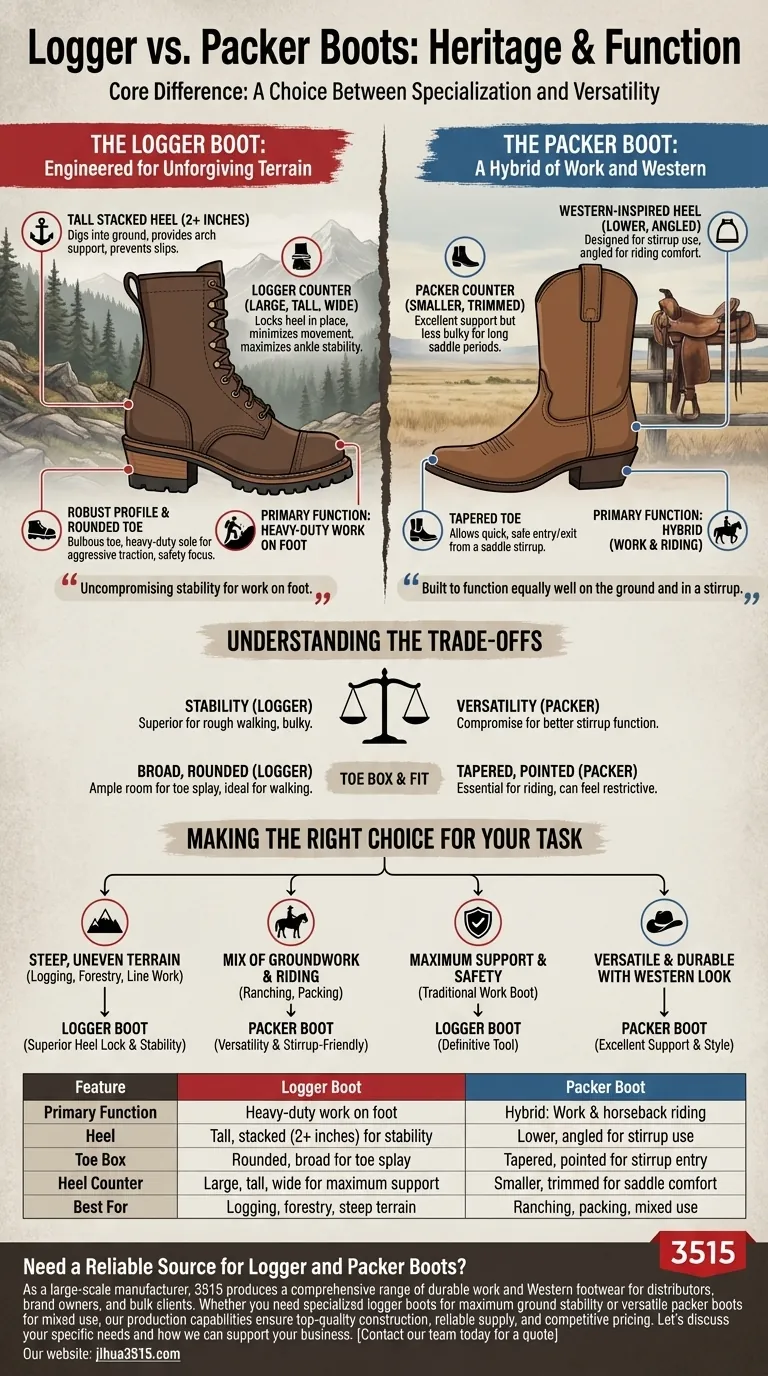
Related Products
- Safety Footwear Wholesale Manufacturer for Custom OEM/ODM Production
- Premium High-Cut Waterproof Safety Boots Manufacturing & Wholesale Solutions
- Custom Wholesale Leather Safety Boots Direct Factory Manufacturing
- Premium Wholesale Waterproof Safety Boots High Performance Protection for Industrial Markets
- Premium Wholesale Wheat Nubuck Safety Boot with Rapid Lacing System
People Also Ask
- What do heavy duty boots do? Protect Your Feet in Demanding Work Environments
- What are OSHA approved shoes? Understanding the Correct Standards for Workplace Safety
- Is it normal to wear shoes in the house? A Guide to Hygiene, Comfort & Culture
- How do safety shoes contribute to cost savings for companies? A Strategic Investment in Risk and Cost Management
- What cultural and environmental considerations are tied to wearing shoes indoors? Balance Hygiene, Tradition, and Foot Health



